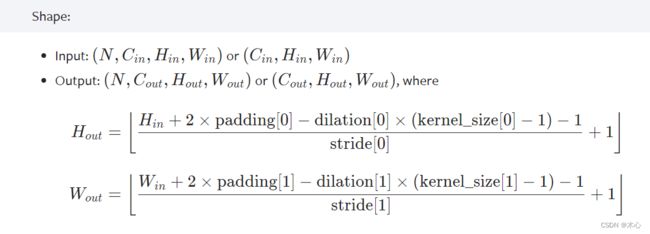Pytorch Tutorial【Chapter 3. Simple Neural Network】
Pytorch Tutorial【Chapter 3. Simple Neural Network】
文章目录
- Pytorch Tutorial【Chapter 3. Simple Neural Network】
-
- Chapter 3. Simple Neural Network
-
- 3.1 Train Neural Network Procedure训练神经网络流程
- 3.2 Build Neural Network Procedure 搭建神经网络
- 3.3 Use Loss Function to Backward 利用损失函数进行反向传播
- 3.4 Update Parameter of NN 更新神经网络参数
-
- 3.4.1 Update Manually手动更新参数
- 3.4.2 Update Automatically自动更新参数
- Reference
Chapter 3. Simple Neural Network
3.1 Train Neural Network Procedure训练神经网络流程
一个典型的神经网络训练过程包括以下几点:
-
定义一个包含可训练参数的神经网络
-
迭代整个输入
-
通过神经网络处理输入
-
计算损失(loss)
-
反向传播梯度到神经网络的参数
-
更新网络的参数,典型的用一个简单的更新方法:weight = weight - learning_rate *gradient
3.2 Build Neural Network Procedure 搭建神经网络
- 定义一个类并继承
torch.nn.Moulde - 使用类
torch.nn中的组件和torch.nn.functional中的组件来搭建网络结构 - 改写该类的
forward方法,在此方法中,进一步完善网络结构(如激活函数,池化层等),并且获得返回值的输出
先简要介绍一下需要使用到的torch.nn组件
torch.nn.Conv2d(in_channels, out_channels, kernel_size)进行卷积操作,输入是 ( N , C i n , H , W ) (N, C_{in},H,W) (N,Cin,H,W),输出是 ( N , C o u t , H , W ) (N,C_{out},H,W) (N,Cout,H,W)(详见Conv2d),卷积对图片尺寸的影响如下
torch.nn.Linear(in_features, out_features)进行放射变换操作(affine mapping),即 y = x A T + b y=xA^T+b y=xAT+b,(详见Linear)torch.nn.Flatten(start_dim=1, end_dim=- 1),将连续的范围展平为张量(详见Flatten)
再介绍一下需要使用到的torch.nn.functional组件
-
torch.nn.functional.relu(),对输入使用Relu激活函数,具体操作是对每个元素都进行 ReLU ( x ) = max ( 0 , x ) \text{ReLU}(x)=\max(0,x) ReLU(x)=max(0,x)的计算,(详见ReLu) -
torch.nn.functional.softmax(),对输入使用Softmax激活函数,具体操作是对每个元素都进行 Softmax ( x i ) = exp ( x i ) ∑ j exp ( x j ) \text{Softmax}(x_i)=\frac{\exp(x_i)}{\sum_{j}\exp(x_j)} Softmax(xi)=∑jexp(xj)exp(xi)(详见Softmax) -
torch.nn.functional.max_pool2d(input, kernel_size, stride), 进行最大池化操作,输入是KaTeX parse error: Expected 'EOF', got '_' at position 28: …atch}, \text{in_̲channels}, iH,i…,详见Max_Pool2D)
例如下述代码,我们要搭建一个下图的神经网络结构
输入是 [ batch , channels , height , weight ] [\text{batch},\text{channels},\text{height},\text{weight}] [batch,channels,height,weight]的图片,分别代表批量大小、通道数、图像的高度、图像的宽度。在我们取批量大小为 1 1 1,然后这个例子变成 [ 1 , 1 , 32 , 32 ] [1,1,32,32] [1,1,32,32],张量的变化过程如下所示
KaTeX parse error: Expected 'EOF', got '_' at position 74: …arrow{\text{max_̲pool}}[1,6,14,1…
import torch
import torch.nn as nn
import torch.nn.functional as F
class Net(nn.Module):
def __init__(self):
super(Net,self).__init__()
# 1 is input_channel 6 is output_channel
self.conv1 = nn.Conv2d(1, 6, 5)
self.conv2 = nn.Conv2d(6, 16, 5)
# affine function y = Wx + b
self.fc1 = nn.Linear(16 * 5 * 5, 120)
self.fc2 = nn.Linear(120, 84)
self.fc3 = nn.Linear(84, 10)
def forward(self,x):
# Max pooling over a (2,2) window
x = F.max_pool2d(F.relu(self.conv1(x)), (2,2))
# If the size is a square you can only specify a single number
x = F.max_pool2d(F.relu(self.conv2(x)), (2,2))
# flat the feature as a vector
x = x.view(-1, self.num_flat_features(x))
x = F.relu(self.fc1(x))
x = F.relu(self.fc2(x))
x = F.softmax(self.fc3(x), dim=1)
return x
def num_flat_features(self,x):
size = x.size()[1:] # all dimensions except the batch dimension
num_feature = 1
for s in size:
num_feature *= s
return num_feature
net = Net()
print(net)
或
class Net(nn.Module):
def __init__(self):
super(Net,self).__init__()
# 1 is input_channel 6 is output_channel
self.conv1 = nn.Conv2d(1, 6, 5)
self.conv2 = nn.Conv2d(6, 16, 5)
# affine function y = Wx + b
self.flat = nn.Flatten(1,-1) # flat the feature
self.fc1 = nn.Linear(16 * 5 * 5, 120)
self.fc2 = nn.Linear(120, 84)
self.fc3 = nn.Linear(84, 10)
def forward(self,x):
# Max pooling over a (2,2) window
x = F.max_pool2d(F.relu(self.conv1(x)), (2,2))
# If the size is a square you can only specify a single number
x = F.max_pool2d(F.relu(self.conv2(x)), (2,2))
# flat the feature as a vector
x = self.flat(x)
x = F.relu(self.fc1(x))
x = F.relu(self.fc2(x))
x = F.softmax(self.fc3(x), dim=1)
return x
net = Net()
print(net)
结果如下,可以查看网络结构
Net(
(conv1): Conv2d(1, 6, kernel_size=(5, 5), stride=(1, 1))
(conv2): Conv2d(6, 16, kernel_size=(5, 5), stride=(1, 1))
(fc1): Linear(in_features=400, out_features=120, bias=True)
(fc2): Linear(in_features=120, out_features=84, bias=True)
(fc3): Linear(in_features=84, out_features=10, bias=True)
)
一个模型可训练的参数可以通过调用 net.parameters() 返回,
params = list(net.parameters())
print(len(params))
print(params[0].size()) # conv1's .weight
结果如下
10
torch.Size([6, 1, 5, 5])
然后我们可以自定义一些输入,来获得网络的输出
input = torch.randn(3, 1, 32, 32)
out = net(input)
print(out.data)
sum = 0
for i in out.data[0]:
sum += i.item()
print(sum)
输出如下
tensor([[0.0996, 0.1000, 0.0907, 0.0946, 0.0930, 0.1067, 0.1044, 0.1119, 0.1073,
0.0918],
[0.0975, 0.1005, 0.0913, 0.0935, 0.0939, 0.1070, 0.1045, 0.1121, 0.1065,
0.0933],
[0.0968, 0.1009, 0.0896, 0.0978, 0.0903, 0.1107, 0.1055, 0.1130, 0.1043,
0.0913]])
0.9999999925494194
torch.nn.Module.zero_grad()把所有参数梯度缓存器置零,
net.zero_grad() #把所有参数梯度缓存器置零,用随机的梯度来反向传播
out.backward(torch.randn_like(out))
net.conv1.bias.grad #查看Conv卷积层的偏置和权重一些参数的梯度
net.conv1.weight.grad
结果如下
tensor([-0.0064, 0.0136, -0.0046, 0.0008, -0.0044, 0.0021])
...
3.3 Use Loss Function to Backward 利用损失函数进行反向传播
现在我们已经完成了
-
定义一个神经网络
-
处理输入以及调用反向传播
还剩下:
-
计算损失值
-
更新网络中的权重
损失函数
一个损失函数需要一对输入:模型输出和目标,然后计算一个值来评估输出距离目标有多远。
有一些不同的损失函数在 nn 包(详细请查看loss-functions)。一个简单的损失函数就是 nn.MSELoss ,这计算了均方误差
input = torch.randn(3, 1, 32, 32)
target = torch.randn(3, 10)
predict = net(input)
criterion = nn.MSELoss()
loss = criterion(predict, target)
print(loss)
print(loss.grad_fn.next_functions[0][0])
我们计算了MSE损失函数,并且能够跟踪其计算图
input -> conv2d -> relu -> maxpool2d -> conv2d -> relu -> maxpool2d
-> view -> linear -> relu -> linear -> relu -> linear -> sfotmax
-> MSELoss
-> loss
当我们使用loss.backward()时,整个计算图都会进行微分,为了实现反向传播损失,我们所有需要做的事情仅仅是使用 loss.backward()。你需要清空现存的梯度,要不然现在计算的梯度都将会和历史保存的梯度累计到一起。
net.zero_grad() # zeroes the gradient buffers of all parameters
print('conv1.bias.grad before backward')
print(net.conv1.bias.grad)
loss.backward()
print('conv1.bias.grad after backward')
print(net.conv1.bias.grad)
结果如下
conv1.bias.grad before backward
None
conv1.bias.grad after backward
tensor([-3.4418e-04, -1.0766e-04, 1.0913e-04, -5.5018e-05, 1.7342e-04,
-5.3316e-04])
3.4 Update Parameter of NN 更新神经网络参数
3.4.1 Update Manually手动更新参数
我们可以手动实现随机梯度下降(stochastic gradient descent)来更新参数(详细请参考Chapter 6. Stochastic Approximation)
w k + 1 = w k − a k ∇ w k f ( w k , x k ) \textcolor{red}{w_{k+1} = w_k - a_k \nabla_{w_k} f(w_k,x_k)} wk+1=wk−ak∇wkf(wk,xk)
learning_rate = 0.01
for f in net.parameters():
f.data.sub_(f.grad.data * learning_rate) #sub_() is in-place minus
3.4.2 Update Automatically自动更新参数
尽管如此,如果你是用神经网络,你想使用不同的更新规则,类似于 SGD, Nesterov-SGD, Adam, RMSProp, 等。为了让这可行,我们建立了一个小包:torch.optim 实现了所有的方法。我们可以使用optim.step()来替代上述手动实现的代码,使用它非常的简单。
import torch.optim as optim
# create your optimizer
optimizer = optim.SGD(net.parameters(), lr=0.01)
# in your training loop:
optimizer.zero_grad() # zero the gradient buffers
output = net(input)
loss = criterion(output, target)
loss.backward() # 计算梯度
optimizer.step() # Does the update
Reference
参考教程1
参考教程2

